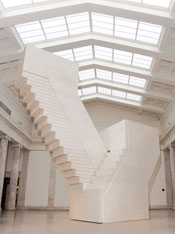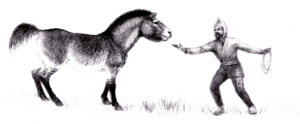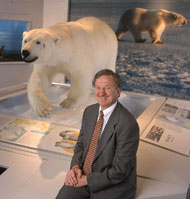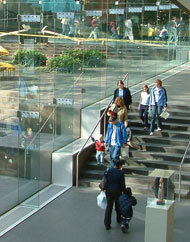These bodies have plenty to say
 Carnegie Science Center welcomes world-renowned BODIES … The Exhibition in October 2007. Featuring more than a dozen specially-preserved human bodies, as well as some 200 additional parts and organs, the exhibit offers an insider’s view of bones, muscles, nerves, and blood vessels. Carnegie Science Center welcomes world-renowned BODIES … The Exhibition in October 2007. Featuring more than a dozen specially-preserved human bodies, as well as some 200 additional parts and organs, the exhibit offers an insider’s view of bones, muscles, nerves, and blood vessels.
Designed to highlight the beauty and complexity of the human body, the show also examines the ravaging effects of diseases like cancer, Parkinson’s, and Alzheimer’s.
It’s populated by bodies from China’s Dalian Medical University’s plastination laboratories, each of which has undergone a polymer preservation process that transforms them into hardened, rubberized specimens destined to last well beyond a lifetime.
Expected to attract several hundred thousand visitors during its six-month run, BODIES … The Exhibition will no doubt prompt visitors to think anew about what’s really going on inside these bodies of ours.
“Some of the most powerful learning experiences come when people experience something that is real; in this case, real human bodies,” says Joanna E. Haas, the Henry Buhl, Jr., director of Carnegie Science Center. “We’re thrilled to have been selected to host the BODIES exhibit, one of the most sought-after exhibitions in the world. We hope every person, young and old, will come to see this illuminating and inspiring exhibition.”
The artistic merits of sharing
 Carnegie Museum of Art and Buffalo’s Albright-Knox Art Gallery have taken an important step in forging a new partnership: They’re sharing art. Specifically, the two organizations have jointly purchased British artist Rachel Whiteread’s Untitled (Domestic), 2002. It arrives in Pittsburgh this fall. Carnegie Museum of Art and Buffalo’s Albright-Knox Art Gallery have taken an important step in forging a new partnership: They’re sharing art. Specifically, the two organizations have jointly purchased British artist Rachel Whiteread’s Untitled (Domestic), 2002. It arrives in Pittsburgh this fall.
Standing 22 x 19 x 8 feet, the piece is actually a cast of an interior staircase found in a 19th- century London building once home to Admiral Lord Nelson. As the inaugural purchase made by the Carnegie and Albright-Knox alliance, it sets the stage for what promises to be a fruitful, long-term relationship.
The staircase is also significant because it so aptly reflects Whiteread’s artistic sensibilities. “Untitled (Domestic) is a great and engaging monument, and is beautifully complemented here at Carnegie Museum of Art by the extensive plaster cast collection assembled by Andrew Carnegie 100 years ago,” says Richard Armstrong, The Henry J. Heinz II Director of Carnegie Museum of Art.
A horse is a horse. Of course?
 For most of us, a horse is a horse. Of course. But for Sandra Olsen, curator of Anthropology at Carnegie Museum of Natural History, the horse is far more. Studying the horse and its interaction with humans tells us a lot about ourselves. For most of us, a horse is a horse. Of course. But for Sandra Olsen, curator of Anthropology at Carnegie Museum of Natural History, the horse is far more. Studying the horse and its interaction with humans tells us a lot about ourselves.
Olsen has devoted a great deal of her professional life to studying the domestication of horses all over the world—in the United States, Europe, and, most recently, northern Kazakhstan. In her most recent contribution to the discussion, Horses and Humans: The Evolution of Human-Equine Relationships, she helps bring together the voices of 33 scholars from seven different nations—including archaeologists, art historians, paleontologists and zoologists—to cover a wide range of horse tales. Olsen is a co-editor of the new book.
From Ice Age horse hunters to the origins of horse domestication, from horses in Tibetan religious texts to the city horses of recent American history, Horses and Humans covers it all. Of course.
Leadership changes at Carnegie Museum of Natural History
 As the new interim co-directors for Carnegie Museum of Natural History, until a new director is found, Zhe-Xi Luo and David A. Smith have a big act to follow and an even bigger one to introduce. As the new interim co-directors for Carnegie Museum of Natural History, until a new director is found, Zhe-Xi Luo and David A. Smith have a big act to follow and an even bigger one to introduce.
For the past six years, the museum has been under the stewardship of Billie (Bill) DeWalt. Leaving Pittsburgh for the warmer environs of Phoenix, Arizona, where he will oversee the opening of the world’s first musical instrument museum, DeWalt recently reflected on his tenure as director of the Museum of Natural History. “We’ve accomplished so many things,” he said, “and I know the museum is poised for great things in the coming months and years.”
One of those things just happens to be the November 2007 debut of Dinosaurs in Their World. Orchestrating the grand opening of this expanded new home for Carnegie Museums’ vast collection of dinosaur fossils will be no small feat for Luo and Smith. But according to Carnegie Museums of Pittsburgh President David Hillenbrand, they are both up to the task.
Luo has served as Carnegie Museum of Natural History’s curator of Vertebrate Paleontology since 1995 and associate director for its Research and Collections department since 2004. Smith has been director of Powdermill Nature Reserve since 2004.
Setting records at the Oakland museums
 What’s in a number? If it happens to be 8,038, it’s a new attendance record. Thanks to the Citizens Bank Foundation, Carnegie Museums of Art and Natural History were open to the public on Monday, January 15, Martin Luther King, Jr. Day—and free. What’s in a number? If it happens to be 8,038, it’s a new attendance record. Thanks to the Citizens Bank Foundation, Carnegie Museums of Art and Natural History were open to the public on Monday, January 15, Martin Luther King, Jr. Day—and free.
The special free day on a school holiday encouraged some 8,000-plus people, many of them families, to visit the two Oakland museums, leaving the previous record of 4,294 (set on the Friday after Thanksgiving in 2000) out in the cold.
Local heroes of science get their due
 For 11 years now, Carnegie Science Center has honored the region’s stars of all things scientific at its annual Awards for Excellence. And on January 31, at a reception at the Science Center, this year’s honorees or “heroes”—16 individuals, three corporations or organizations, and one school district—were announced. They’ll be celebrated in person at the 2007 Awards for Excellence event on May 2, to be held at Carnegie Music Hall in Oakland. For 11 years now, Carnegie Science Center has honored the region’s stars of all things scientific at its annual Awards for Excellence. And on January 31, at a reception at the Science Center, this year’s honorees or “heroes”—16 individuals, three corporations or organizations, and one school district—were announced. They’ll be celebrated in person at the 2007 Awards for Excellence event on May 2, to be held at Carnegie Music Hall in Oakland.
The winners receive $1,000 in cash and the appreciation of a community of science-and-technology achievers that grows larger and more accomplished every year. That community includes Eaton Corporation, which for the past decade has partnered with the Science Center on the awards program.
This year’s Chairman’s Award went to PPG Industries Inc. And in a new category that honors achievement in science by an emerging female scientist, Kay M. Brummond, Ph.D., a University of Pittsburgh chemistry professor, took the honors.
Following are all of the talented and heroic award winners:
Advanced Manufacturing & Materials, Parag Hegde, Aharon Inspektor, Ph.D., and Ronald Penich, Kennametal Inc. Catalyst Award, Mark H. Kryder, Ph.D., Seagate Research. Corporate Innovation, Kennametal Inc. Entrepreneur, Ronald P. Bianchini, Jr., Network Appliance, Inc. Environmental, Mascaro Sustainability Institute, University of Pittsburgh, Eric Beckman and Gena Kovalcik. Information Technology, Sridhar Tayur, Ph.D., SmartOps®. Journalism, Cara J. Hayden, Pitt Magazine, University of Pittsburgh. Life Sciences, Harvey S. Borovetz, Ph.D., University of Pittsburgh.
Education awards went to: Elementary Educators, Susan Simmers, Pittsburgh Public Schools. Middle Level Educator, Cheryl Kestner, Lorraine Kuniak, James Musolino and Evelyn Quade, Mary Queen of Apostles School. High School Educator, Jason Lucia, North Catholic High School. University / Post-Secondary Educator, Sanjeev Shroff, Ph.D., University of Pittsburgh. School District, Jeanette City School District.
Back to Home
|
 Spring 2007
Spring 2007

 Carnegie Science Center welcomes world-renowned BODIES … The Exhibition in October 2007. Featuring more than a dozen specially-preserved human bodies, as well as some 200 additional parts and organs, the exhibit offers an insider’s view of bones, muscles, nerves, and blood vessels.
Carnegie Science Center welcomes world-renowned BODIES … The Exhibition in October 2007. Featuring more than a dozen specially-preserved human bodies, as well as some 200 additional parts and organs, the exhibit offers an insider’s view of bones, muscles, nerves, and blood vessels.  Carnegie Museum of Art and Buffalo’s Albright-Knox Art Gallery have taken an important step in forging a new partnership: They’re sharing art. Specifically, the two organizations have jointly purchased British artist Rachel Whiteread’s Untitled (Domestic), 2002. It arrives in Pittsburgh this fall.
Carnegie Museum of Art and Buffalo’s Albright-Knox Art Gallery have taken an important step in forging a new partnership: They’re sharing art. Specifically, the two organizations have jointly purchased British artist Rachel Whiteread’s Untitled (Domestic), 2002. It arrives in Pittsburgh this fall.  For most of us, a horse is a horse. Of course. But for Sandra Olsen, curator of Anthropology at Carnegie Museum of Natural History, the horse is far more. Studying the horse and its interaction with humans tells us a lot about ourselves.
For most of us, a horse is a horse. Of course. But for Sandra Olsen, curator of Anthropology at Carnegie Museum of Natural History, the horse is far more. Studying the horse and its interaction with humans tells us a lot about ourselves. As the new interim co-directors for Carnegie Museum of Natural History, until a new director is found, Zhe-Xi Luo and David A. Smith have a big act to follow and an even bigger one to introduce.
As the new interim co-directors for Carnegie Museum of Natural History, until a new director is found, Zhe-Xi Luo and David A. Smith have a big act to follow and an even bigger one to introduce.  What’s in a number? If it happens to be 8,038, it’s a new attendance record. Thanks to the Citizens Bank Foundation, Carnegie Museums of Art and Natural History were open to the public on Monday, January 15, Martin Luther King, Jr. Day—and free.
What’s in a number? If it happens to be 8,038, it’s a new attendance record. Thanks to the Citizens Bank Foundation, Carnegie Museums of Art and Natural History were open to the public on Monday, January 15, Martin Luther King, Jr. Day—and free. For 11 years now, Carnegie Science Center has honored the region’s stars of all things scientific at its annual Awards for Excellence. And on January 31, at a reception at the Science Center, this year’s honorees or “heroes”—16 individuals, three corporations or organizations, and one school district—were announced. They’ll be celebrated in person at the 2007 Awards for Excellence event on May 2, to be held at Carnegie Music Hall in Oakland.
For 11 years now, Carnegie Science Center has honored the region’s stars of all things scientific at its annual Awards for Excellence. And on January 31, at a reception at the Science Center, this year’s honorees or “heroes”—16 individuals, three corporations or organizations, and one school district—were announced. They’ll be celebrated in person at the 2007 Awards for Excellence event on May 2, to be held at Carnegie Music Hall in Oakland.